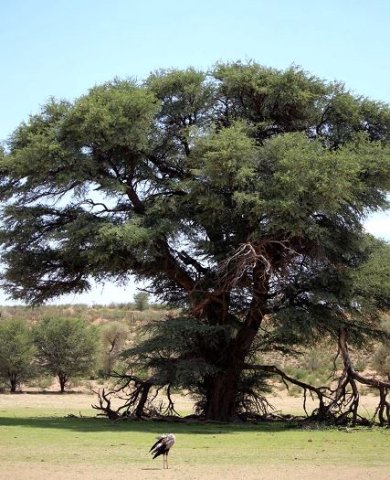Vachellia erioloba and plover

Author: Ivan Lätti
Photographer: Eric Aspeling
The old camel thorn developed a broad crown, somewhat shallowly domed and fairly dense. Deep, dark furrows on the trunk and main branches increase with age.
Camel thorns are vicious. Coates Palgrave tells an old story of a lion falling into a dense mass of these thorns during a hunt and died there.
The camel thorn name for Vachellia erioloba is based on an error that slipped in over time: The tree was originally named in Afrikaans for the giraffe, the kameelperd as there were no camels in southern Africa when the Europeans arrived. Camels were introduced later, while giraffes were and are common.
Saying kameelperddoring (giraffe thorn) was cumbersome, losing the perd (horse) part in the wash. So, kameeldoring it was, in due course translated to camel thorn. The camel thorn name stays, the giraffe thorn and kameelperddoring of purism lost against real language, grown naturally by people over time.
There is a second possible explanation for not hearing kameelperddoring: As leopards were called tiere (tigers) in Afrikaans in olden times (and sometimes still), kameelperde were commonly, informally called kamele (camels). Maybe the old Dutch immigrants and their offspring had never seen camels, thought the name was good for the long-neck creatures they did see. Language does not relinquish its established acquisitions easily when errors of meaning are discovered afterwards.
Similarly, the Afrikaans name seekoei (sea cow) for a hippopotamus was created by (probably zoologically ignorant) Dutch settlers in the Cape, slowly crafting a new language. Seekoei must have sounded appropriate for the newly encountered animal, recalling the sea cow name of certain marine mammals of the order Sirenia, (including the walrus); animals they probably also did not know.
Other languages picked differently. The Greek words hippo meaning horse and potamus meaning river brought about the hippopotamus name that exists in Greek, Latin and English. (The Germans call it Nilpferd, horse of the Nile.)
The Afrikaans antelope names of steenbok and ribbok also denote different local animals to those bearing the similar sounding names in Europe (Coates Palgrave, 2002; Wikipedia).

